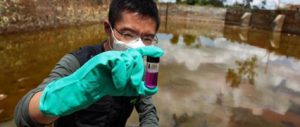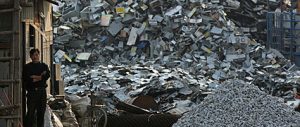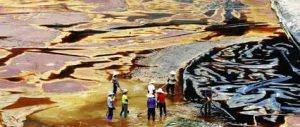This article, by Feng Wei, was originally published in Yunnan Information Daily on August 16, 2011. It brought to public attention the plight of villagers affected by chromium pollution in south-west China, which went on to become a national news story.
This week, Feng won the “best scoop” category in the 2012 China Environmental Press Awards, organised by chinadialogue, The Guardian and Sina, with the support of the SEE Foundation.
The goats are dead, the pigs are dead and you can’t drink the water.
Residents of Yuezhou township, Qujing city, are in despair: their well water has turned yellow, their livestock are dying and their crops are withering.
For months, chemical waste illegally dumped near the shores of Chachong Reservoir, in this corner of Yunnan province, south-west China, was quietly poisoning the community’s main water supply. Rainwater, contaminated after falling on piles of poisonous chromium tailings, flowed into the 300,000-cubic metre reservoir, turning it toxic. Levels of deadly hexavalent chromium peaked at over 200 times permitted levels.
The local government has said that the crisis is now under control. The water has been made safe, they say, through chemical precipitation and dilution techniques and the treated water – declared “no longer dangerous” by Qujing city’s environmental authorities – is being pumped into the Nanpan River, the source of the Pearl River.
Toxic water
In March 2011, a procession of trucks started carting “yellow and black soil” towards the sandy land west of the village. Nobody noticed this “soil” was then being dumped by the roadside. Later calculations put the quantity of abandoned material at 140 loads, or 5,000 tonnes.
Then things got strange. First, some 70 mountain goats mysteriously died. And then farmers’ pigs, afflicted with swollen stomachs just like the goats, started dying off too. The water from the well changed – it smelled strange and white shirts turned yellow when they were washed.
Frightened by what was happening to their clothes, the locals stopped drinking the well water. An eight-metre well at the Kaifeng Brick Kiln, drilled at the start of the year to service 100 workers, was abandoned. Instead, the workers started carrying water from taps in the village, filling five 50-litre buckets twice each day.
Problems continued, and the three main crops in Yangqiying and Zhaishang villages were affected: tobacco leaves turned yellow and speckled, while rice and corn showed poor growth.
When the villagers found out about the dumping, they tried to stop the trucks, but to no avail. The drivers started coming at night so as to avoid them, and the dumping continued for more than a month.
The locals were worried. Village cadre Yang Yongsheng and other local officials took the matter up with their superiors. The environmental authorities quickly came to inspect the site and told the villagers not to drink the water, or to use it for livestock or irrigation, but did not explain why.
The land where the tailings were dumped is barren now: not a single blade of grass grows here. Pine trees cover the hillside above, but more and more dead trees come into view as you approach the dumping ground. Once-green pine needles look shrivelled and yellow, while dense patches of strange colour cover the ground: white, yellow and a light purple.
The villagers have since learned that the chromium tailings which have brought them so much grief came from Luliang Chemicals.
Poisoned pond
Lu Shaofei, head of monitoring at the Environmental Protection Bureau for the local district of Qilin, worked on the clean-up. After being alerted to the problem, the local government promptly placed a rainproof cover over the waste piles, put up warning signs, dug a ditch to catch polluted water and arranged for the site to be patrolled. It also made sure dead livestock were not eaten or sold.
The authorities quickly identified the hazardous waste as chromium tailings dumped by Luliang Chemicals. This company claims to be Asia’s largest producer of the chemical compound menadione, or vitamin K3. It is also one of Asia’s largest manufacturers of chromium salts: each year, it produces tens of thousands of tonnes of them. Chromium tailings are a waste product from the manufacturing of chromium salts and metallic chromium.
The company was given three days to move the tailings, along with any contaminated soil and water, to a safe place. And so, over the course of three days, 9,000 tonnes of tailings and soil were removed.
Data later gathered on the environmental impact were shocking: a pond upstream of the reservoir had hexavalent chromium readings 2,000 times above normal levels. It was this pond that the goats drank from. Levels of the toxin in Chachong Reservoir itself peaked at 200 times above standards.
Excessive levels of hexavalent chromium were also found at the entrance to Huangnibao Reservoir, which lies downstream of Chachong. Huangnibao holds seven to eight milion cubic metres of water, and is used by over 80,000 people and their livestock. The government used bulldozers to erect an earth dam to block contaminated water.
“Cleaning up”
Tailings disposal is the biggest headache for China’s chromium industry. Containing 1% to 2% of calcium chromate (a carcinogen) and 0.5% to 1% of water-soluble hexavalent chromium (a deadly poison), these tailings are toxic. And currently, there are no really effective and economic methods available to treat it.
Hexavalent chromium is easily absorbed by humans and contact can irritate the skin and damage DNA. It is not easily expelled from the body and, at high dosages, can cause cancer. It represents a sustained, environmental threat.
In this case, the hexavalent chromium was treated with the reducing agent sodium metabisulfite, a process that converted it into the less dangerous trivalent chromium. Once it had settled, alkali was added to reduce acidity.
The government installed pumps and dug a channel to take the 300,000 cubic metres of water to the Nanpan River. During this process, the environmental authorities of Qujing city, Qilin district and Luliang county, divided their stretches of the Nanpan into five sections and tested each twice daily.
Some experts say that, in the natural environment, it takes a century for hexavalent chromium in water to lose its toxicity. But Yu Haisheng, deputy head of the city’s environmental monitoring station, reported that the treated water was already up to national quality standards by the time it was discharged into the Nanpan River, and that no hexavalent chromium has since been detected in the waters of the river. He also explained that his office is only responsible for the stretch of the river within Qujing city – his team did not think to alert the authorities downstream about its actions so that they could carry out their own monitoring.
Once the reservoir was pumped dry, the mud at the bottom was dug out and delivered to the nearby kiln, to be mixed with clay and baked into bricks. As the hexavalent chromium had already been turned into the less dangerous trivalent chromium, and the baking process would also reduce toxicity, the idea was that this would remove any remnant pollution risks.
The chemical plant by the river
This was the first time Yang Yongsheng and his neighbours came up against chromium pollution, but the residents of Xinglong village, where Luliang Chemicals is located, have long known its dangers. Media reports have described Xinglong as “a village slowly dying”.
Local Wang Heyun said that 37 villagers have died of various forms of cancer since 2006. Chang Heibao, Wang Xiaogou, Wang Jianming, Liu Moxian, Cui Zhucun, Dong Shikun – these are just some of the names of the deceased.
Another villager, Zhang Jiarong, reported that countless head of livestock have died. The surrounding area is badly polluted with hexavalent chromium. Harvests are very likely to fail: even when crops grow, they are too contaminated to eat, and nobody buys them. The villagers live under the constant shadow of environmental damage.
Investigations carried out by the local authorities responsible for disease control and environmental protection were “unable to confirm” a link between the cancer cases and the chemical factory. The cancer could be caused by bad dietary habits, such as eating fermented pickles, drinking alcohol or exposure to agricultural chemicals, the findings said.
Outside Xiqiao Industrial Zone, home to Luliang Chemicals, a billboard declares “join us in stronger pollution control and the construction of an environmentally friendly industrial zone”. Founded in the 1960s, the zone now hosts paper mills, chemical plants, building materials factories and smelting firms – with 42 companies in all, it is Luliang county’s main industry cluster.
The chromium tailings have been placed several hundred metres behind the factory, piled up like a miniature mountain range and guarded by a “chromium tailings, no grazing” sign. Nearby is the Nanpan River. It has been a dry year, so water levels are low and the black, malodorous water flows slowly downstream. The river is lined with factories; tall chimneys pump out dark smoke.
Qujing city’s environmental authorities revealed that two truck drivers have been arrested for illegally dumping chromium tailings and that criminal investigations are under way.
Yang Yongsheng said that the village hasn’t had any contact with the factory and that no monetary value has been placed on the harm caused by the pollution. Meanwhile, Lu Shaofei of Qilin district’s environmental authority said that compensation has not yet been discussed. The next step, he said, would be to engage a qualified agency to assess the damages. The government hasn’t yet issued a verdict on the case. Although chromium pollution is extremely serious, in this instance it was dealt with quickly, and there were no human casualties.
Feng Wei is a reporter at Yunnan Information Daily and winner of the “best scoop” category at the 2012 China Environmental Press Awards.
The 2012 China Environmental Press Awards were co-organised by chinadialogue and The Guardian, in cooperation with Sina and with the support of the SEE Foundation. The annual awards aim to recognise and promote outstanding environmental journalism in China.
Homepage image from Greenpeace


